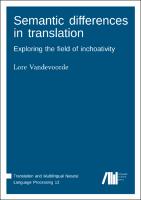Semantic differences in translation
Exploring the field of inchoativity
| dc.contributor.author | Vandevoorde, Lore | |
| dc.date.accessioned | 2020-12-15T13:57:45Z | |
| dc.date.available | 2020-12-15T13:57:45Z | |
| dc.date.issued | 2020 | |
| dc.identifier | OCN: 1229399854 | |
| dc.identifier.uri | https://library.oapen.org/handle/20.500.12657/43780 | |
| dc.description.abstract | Although the notion of meaning has always been at the core of translation, the invariance of meaning has, partly due to practical constraints, rarely been challenged in Corpus-based Translation Studies. In answer to this, the aim of this book is to question the invariance of meaning in translated texts: if translation scholars agree on the fact that translated language is different from non-translated language with respect to a number of grammatical and lexical aspects, would it be possible to identify differences between translated and non-translated language on the semantic level too? More specifically, this books tries to formulate an answer to the following three questions: (i) how can semantic differences in translated vs non-translated language be investigated in a corpus-based study?, (ii) are there any differences on the semantic level between translated and non-translated language? and (iii) if there are differences on the semantic level, can we ascribe them to any of the (universal) tendencies of translation? In this book, I establish a way to visually explore semantic similarity on the basis of representations of translated and non-translated semantic fields. A technique for the comparison of semantic fields of translated and non-translated language called SMM++ (based on Helge Dyvik’s Semantic Mirrors method) is developed, yielding statistics-based visualizations of semantic fields. The SMM++ is presented via the case of inchoativity in Dutch (beginnen [to begin]). By comparing the visualizations of the semantic fields on different levels (translated Dutch with French as a source language, with English as a source language and non-translated Dutch) I further explore whether the differences between translated and non-translated fields of inchoativity in Dutch can be linked to any of the well-known universals of translation. The main results of this study are explained on the basis of two cognitively inspired frameworks: Halverson’s Gravitational Pull Hypothesis and Paradis’ neurolinguistic theory of bilingualism. | |
| dc.language | English | |
| dc.subject.classification | thema EDItEUR::C Language and Linguistics::CF Linguistics | en_US |
| dc.subject.other | Language Arts & Disciplines | |
| dc.subject.other | Linguistics | |
| dc.subject.other | General | |
| dc.title | Semantic differences in translation | |
| dc.title.alternative | Exploring the field of inchoativity | |
| dc.type | book | |
| oapen.identifier.doi | https://doi.org/10.5281/zenodo.2573677 | |
| oapen.relation.isPublishedBy | 0bad921f-3055-43b9-a9f1-ea5b2d949173 | |
| oapen.relation.isFundedBy | b818ba9d-2dd9-4fd7-a364-7f305aef7ee9 | |
| oapen.relation.isbn | 9783961100736 | |
| oapen.collection | Knowledge Unlatched (KU) | |
| oapen.imprint | Language Science Press | |
| oapen.identifier | https://openresearchlibrary.org/viewer/30ec8384-0fea-4844-a31d-b96e9d565e2e | |
| oapen.identifier.isbn | 9783961100736 | |
| grantor.number | 105994 |

